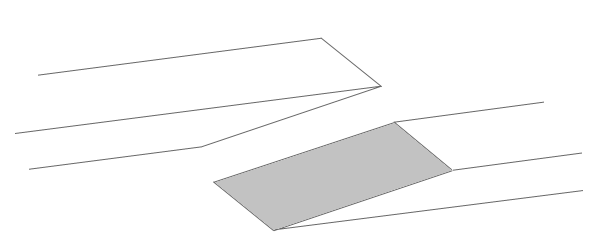
Scarf joint
Encyclopedia

Woodworking
Woodworking is the process of building, making or carving something using wood.-History:Along with stone, mud, and animal parts, wood was one of the first materials worked by early humans. Microwear analysis of the Mousterian stone tools used by the Neanderthals show that many were used to work wood...
or metalworking
Metalworking
Metalworking is the process of working with metals to create individual parts, assemblies, or large scale structures. The term covers a wide range of work from large ships and bridges to precise engine parts and delicate jewelry. It therefore includes a correspondingly wide range of skills,...
. The scarf joint is used when the material being joined is not available in the length required. It is an alternative to other joints such as the butt joint
Butt joint
A butt joint is a joinery technique in which two members are joined by simply butting them together. The butt joint is the simplest joint to make since it merely involves cutting the members to the appropriate length and butting them together. It is also the weakest because unless some form of...
and the splice joint
Splice joint
A splice joint is a method of joining two members end to end in woodworking. The splice joint is used when the material being joined is not available in the length required. It is an alternative to other joints such as the butt joint and the scarf joint. Splice joints are stronger than unreinforced...
and is often favored over these in joinery
Joinery
Joinery may refer to:* Woodworking joints or other types of mechanical joints * The work of the joiner, the fabrication and installation of fittings in buildings with materials such as wood and aluminum * In Australia and New Zealand, a joinery is also the generic term for a business which...
because it yields a barely visible glue line.
The scarf joint in wood
In woodworking, there are two distinctly different categories of scarf, based on whether the joint has interlocking faces or not. A plain scarf is simply two flat planes meeting on an angle relative to the axis of the stock being joined, and depends entirely on adhesive and/or mechanical fastening (screws, bolts, etc.) for all strength. Hooked, keyed, and nibbed scarfs are some of the many example of interlocking scarfs, offering varying degrees of tensile and compressive strength, though most still depend on mechanical fastening to keep the joint closed.The plain scarf is not preferred when strength is required, so it is often used in decorative situations, such as the application of trim or moulding. The use of modern high-strength adhesives can greatly increase the structural performance of a plain scarf.
The keyed hook scarf is common in ship
Ship
Since the end of the age of sail a ship has been any large buoyant marine vessel. Ships are generally distinguished from boats based on size and cargo or passenger capacity. Ships are used on lakes, seas, and rivers for a variety of activities, such as the transport of people or goods, fishing,...
and boat-building
Boat building
Boat building, one of the oldest branches of engineering, is concerned with constructing the hulls of boats and, for sailboats, the masts, spars and rigging.-Parts:* Bow - the front and generally sharp end of the hull...
, as well as timber framing and wooden bridge construction. In large timbers such as these the scarf is virtually always secured with through bolts, and is frequently reinforced externally with iron or steel fishplates, and/or strapping.
A scarf joint may also be used to fix problems caused when a board is cut too short for the application. The board can be cut in half with a tapered cut yielding a scarf joint. When the joint is glued together, the tapers are slid against each other so that the two sections are no longer in line with each other. This has the effect of making the board longer. Once the glue has set, the board can be planed down to an even thickness, resulting in a longer but thinner board.
Methods
The joint is formed by cutting opposing tapered ends on each member which are then fitted together. When working with woodWood
Wood is a hard, fibrous tissue found in many trees. It has been used for hundreds of thousands of years for both fuel and as a construction material. It is an organic material, a natural composite of cellulose fibers embedded in a matrix of lignin which resists compression...
, this gives better long grain to long grain gluing surface, which yields a stronger joint than would be achieved with a simple butt joint. The tapers are generally cut at an angle between 1:8 to 1:10. The ends of a plain scarf are feathered to a fine point which aids in the obscuring of the joint in the finished work, while in other forms of scarf the ends are frequently cut to a blunt "nib" which engages a matching shoulder in the mating piece.
Where scarfed joints are used in the restoration of vintage aircraft most developed countries will only issue an airworthyness certificate if all such joints have used an angle no less than 1:8.

